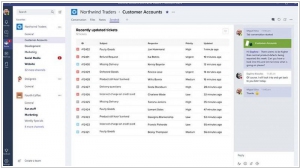Microsoft Teams vs Slack
June 07, 2023 | Author: Adam Levine
49

Slack brings all your communication together in one place. It's real-time messaging, archiving and search for modern teams. Create open channels for the projects, groups and topics that the whole team shares. Slack searches whole conversations, not just individual messages, so you can find what you’re looking for no matter who said what or when they said it.
Microsoft Teams and Slack are two leading collaboration platforms that offer a range of features for team communication and productivity. Microsoft Teams, part of the Microsoft 365 suite, provides a comprehensive solution with chat, video meetings, file sharing, and integration with other Microsoft tools. It offers a seamless experience for organizations already using Microsoft products and services, with deep integration into apps like Outlook, SharePoint, and OneDrive. Slack, on the other hand, focuses on team messaging, channels, and integrations with a wide range of third-party tools and services. It emphasizes flexibility, customization, and a user-friendly interface. Slack is known for its extensive app directory and the ability to create custom workflows through integrations.
See also: Top 10 Team Messaging platforms
See also: Top 10 Team Messaging platforms
Microsoft Teams vs Slack in our news:
2023. Microsoft’s AI-powered Designer tool comes to Teams
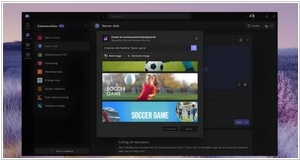
Microsoft is introducing its AI-driven art creation tool, Designer, to the free version of Teams. Users of Microsoft Teams can now utilize Designer, an app similar to Canva, to generate various designs for presentations, posters, digital postcards, and other purposes. These designs can be shared on social media platforms and other channels. Designer can generate designs based on text prompts or uploaded images by leveraging DALL-E 2, OpenAI's text-to-image AI. The tool offers options for customization and personalization through drop-down menus and text boxes. Designer is accessible through the web, Microsoft's Edge browser via the sidebar, and now within the free version of Teams. The announcement of Designer was initially made in October, and new features such as caption generation and animated visuals were added in April. Microsoft has also promised additional advanced editing features in the future.
2023. Microsoft rebuilt Teams from the ground up, promises 2x faster performance
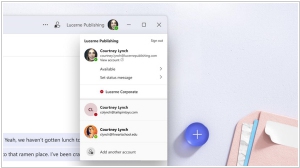
Microsoft Teams, which competes with Slack, has had a reputation for being slow and resource-intensive since its launch, which some attributed to Microsoft's rushed response to Slack's success. However, Microsoft has now launched a preview of a new version of Teams that it describes as a "reimagining of Teams from the ground up." The new application promises to offer twice the performance of the previous version while using only half the memory. This means that joining meetings should be twice as fast, and switching between chats and channels will be 1.7 times faster. The company has also redesigned the user experience of the platform.
2022. Microsoft Teams targets Facebook Groups with new Communities feature
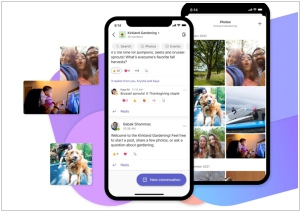
Microsoft Teams has recently introduced an exciting feature called "Communities" for Android and iOS devices. This new feature enables users to create and organize groups within their community, such as sports clubs, event planning committees, parent-teacher associations, and more. With Communities in Microsoft Teams, users gain access to a range of collaborative tools and functionalities, including group calendars, event scheduling, document and photo sharing, video calls, and chat capabilities. Additionally, the feature offers a "new events experience" that allows users to add events to their community calendar, invite guests, track attendance, and engage in private conversations with attendees. Currently, Communities is available in the free version of Microsoft Teams and is initially accessible on mobile devices, with plans for desktop compatibility in the near future. This new addition aims to enhance community collaboration and streamline communication within Microsoft Teams' user-friendly interface.
2022. Meta partners with Microsoft to bring VR to Teams
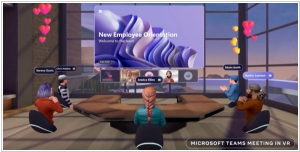
Meta has recently announced a strategic partnership with Microsoft, aimed at incorporating Windows apps and integrating Microsoft Teams functionalities into Meta's metaverse hardware endeavors. This collaboration entails the integration of Microsoft Teams with Quest devices, enabling seamless communication and collaboration. Furthermore, Microsoft will provide a solution to stream Windows apps directly to Meta's headsets. The partnership also paves the way for the inclusion of custom 3D avatars in the metaverse experience. In terms of collaboration, Meta's VR space for teamwork, Horizon Workrooms, will be connected with Teams, allowing users to join Teams meetings directly from Workrooms. Additionally, Microsoft 365 will be accessible on Quest, enabling users to interact with content from productivity applications such as Word, Excel, PowerPoint, and Outlook. Notably, these are not full-fledged VR versions of the apps but rather Progressive Web Apps designed for the purpose.
2022. Slack adds persistent information layer to channels called Canvas
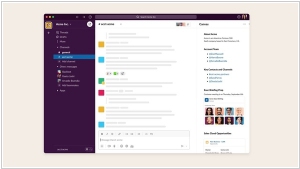
Slack has achieved considerable success in the enterprise realm by offering various communication options and seamless integration with common enterprise applications. However, until now, Slack has lacked a persistent way to share project-related information. While users could create channels to narrow down content and share documents, links, and other materials, finding them again required searching or extensive scrolling. Acknowledging this limitation, Slack has taken a step forward by combining the collaborative tooling of Quip with Slack's communication capabilities, resulting in a new tool called Canvas. Positioned alongside a channel's conversation stream, Canvas grants users access to a range of information, including data and charts, text, tasks, internal and external links, training videos, and more. This integration allows for a seamless experience where project-related information can be easily shared and accessed within the Slack platform.
2022. Slack gains new automation features, including conditional logic for workflows
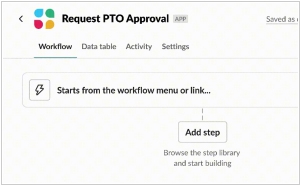
Announcing a significant update, Slack has introduced new automation features aimed at enhancing the shareability and discoverability of workflows. Building upon the existing Workflow Builder tool launched in 2019, these latest capabilities enable users to easily send workflows to other Slack users and utilize "if-then" statements to create more advanced flows. Slack's increased focus on automation aligns with the growing popularity of no-code development tools, which empower users to build apps and pipelines without requiring programming expertise. According to a survey conducted by 451 Research and FileMaker, nearly 60% of all custom apps, including automations, are now developed outside of the IT department. Furthermore, the survey revealed that 30% of these apps are created by employees with limited or no technical development skills. This trend emphasizes the importance of providing accessible automation solutions to a broader range of users.
2022. Slack is increasing prices and changing the way its free plan works
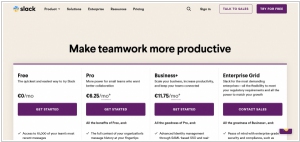
Slack, the chat platform widely used as an online watercooler for numerous teams, is implementing changes to its pricing structure and free plan functionality. For users subscribed to the "Pro" plan on a monthly basis, the price will increase from $8 per user per month to $8.75 per user per month. Similarly, for users on the annual "Pro" plan, the price will rise from $6.67 per user per month to $7.25 per user per month. As for the free plan, Slack is modifying how messages are stored. Previously, free users had access to the last 10,000 messages and 5 GB of uploads. Going forward, message retention will be based on time rather than quantity, allowing free users to view the last 90 days' worth of messages and uploads, regardless of the volume exchanged.
2021. Microsoft Teams gets 3D animated avatars
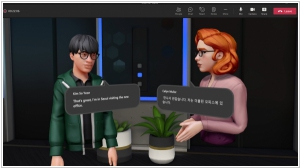
Microsoft has unveiled 3D avatars for Teams meetings, offering an alternative for those who prefer not to appear on camera. These animated and personalized avatars are part of the "Mesh for Teams" initiative, which combines Microsoft's Mesh platform for shared experiences in virtual reality, augmented reality, and other realms with Teams and its integrated productivity tools. This feature transforms traditional meetings into a unique experience. Users can access Mesh for Teams using various devices, ranging from smartphones to VR headsets or HoloLens. Microsoft also allows businesses to create their own spaces, or metaverses, within Teams, enabling individuals to virtually interact and collaborate.
2021. Salesforce announces first integrations with Slack
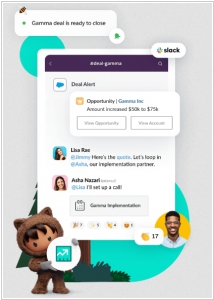
When Salesforce completed its acquisition of Slack towards the end of the previous year, it was evident that they had ambitious plans for the company. Today, the renowned CRM giant has unveiled the initial integrations that are set to benefit Salesforce customers. To begin with, the Sales Cloud now offers dedicated deal rooms. These rooms allow all parties involved in a complex sale, including internal departments such as finance and product teams, as well as external partners, to collaborate within Slack throughout the sales cycle. This enables them to stay updated on the fluctuations and progress of all sales activities. By leveraging Slack's capability to integrate external enterprise applications within its platform, the goal is to foster collaboration and discover methods to streamline and automate various Salesforce tasks. This ultimately results in faster and more efficient usage of Salesforce, eliminating the need to switch contexts in order to achieve desired outcomes.
2021. Slack now lets you DM employees in other companies
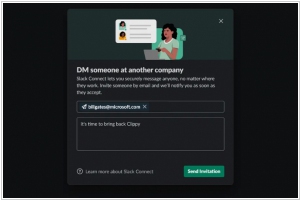
Slack has recently introduced a new feature that enables users of the platform to send direct messages to each other. Known as Slack Connect DMs, this functionality allows Slack users to privately communicate with individuals outside their own company. While primarily intended for companies collaborating with partners or clients, it can also be utilized to message friends employed at other companies. This new DM feature expands on Slack's existing Connect feature, which was introduced last year. Slack Connect primarily facilitates business collaboration through shared channels, and cross-organizational DMs represent the next significant aspect of Connect. To initiate a DM, users send a special link to start a conversation, and depending on your organization's Slack setup, Slack admin approval may be required.

